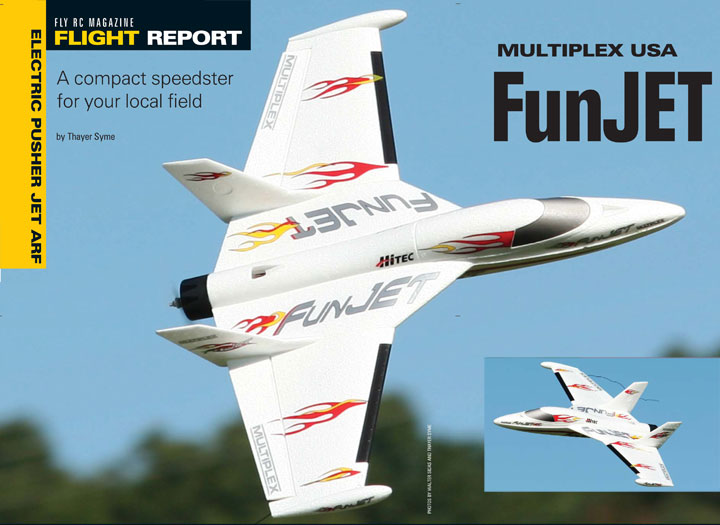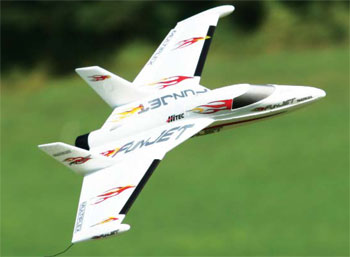
The new FunJET from Multiplex USA is the latest in their continuing line of smallish jet type models designed for all-out fun. The FunJET assembles from just seven molded foam pieces, and it can easily be completed in a relaxed evening. I spread it across two evenings to install the radio and to add the decals.
TIPS FOR SUCCESS
The FunJET practically falls together as you take it out of the box. I challenge any of you not to hold the raw parts together for a preview of what is to come. The funny thing is, once you are done making the airplane noises, actual assembly doesnt take much longer than the dry fit. All assembly is done with conventional medium CA. Foam-safe CA and epoxy are not recommended for the Elapor foam. When joining two parts, I fogged a bit of Zip Kicker onto one of the parts, and let it air dry as I applied medium Zap to the other. Bring the pieces together with a firm push, wait a second or two, and that joint is done. Amazingly, you only need to do this six times to complete the airframe. Seven more glue cycles take care of the control horns, canopy latch and motor mount. This is all very basic assembly, but be sure to follow along with the manual. There are a couple of places where you really want to do things in order: installing the main spar and servos before gluing on the fuselage deck, is one. It is possible to distort the fuselage a little when installing the spar, so use the upper deck as a guide to check the fuselage.
| SPECSPLANE: FunJET MANUFACTURER: Multiplex Modelsport DISTRIBUTOR: Multiplex USA TYPE: Foam pusher jet FOR: Intermediate pilots WINGSPAN: 31.5 in. WING AREA: 232 sq. in. FLYING WEIGHT: 21.6 oz. |
WING LOADING: 13.4 oz./sq. ft. LENGTH: 28.75 in. RADIO: 3 channels required; flown with a Hitec Optic 6 transmitter, Hitec Electron 6 receiver, Hitec HS-65HB servos POWER SYSTEM: Multiplex Permax BL-480/5D brushless motor, APC 5.5×4.5 prop, Multicon BL-37 ESC, Venom Power 3S 2100mAh Li-Poly battery FULL THROTTLE POWER: 24.9 amps, 254.5 watts; 11.78 W/oz., 188.5 W/lb. |
TOP RPM: 20,430 DURATION: 15 minutes, mixed flying MINIMAL FLYING AREA: Gymnasium, sports field PRICE: $59.99 COMPONENTS NEEDED TO COMPLETE: 3-channel radio with elevon mixing, 2 mini servos, servo extensions, brushless motor, ESC, battery and propeller. |
| SUMMARYFrankly, the name says it all. This little pusher jet is all about fun. The Elapor foam airframe goes together very quickly, and the equipment setup is just as fast. At the field, youll have plenty of power for high-speed passes and exciting climbs and an airframe that is tough to hurt. This is a great little scorcher to leave in the car and fly whenever the mood strikes.
|
||

CONCLUSION
Multiplex has hit a home run with the FunJET. This little speedster flies fast and smooth, and it can take its share of hits without losing any performance. This is definitely one jet you will want in your fleet.
Links
Hitec RCD USA, Inc., www.hitecrcd.com, (858) 748-6948
Multiplex, www.multiplexusa.com, (858) 748-6948
Venom Air Corps., www.venom-aircorps.com, (800) 705-0260
W.S. Deans, www.wsdeans.com, (714) 828-6494
ZAP is manufactured by Pacer Technology, www.zapglue.com
ZLog recording altimeter, Hexpert Systems, www.hexpertsystems.com
AIRBORNEIm always a little nervous about hand launching pusher designs, but this one is about as mild as they come. Because the prop barely extends below the back of the fuselage, once you release the model, your hand will be well clear of the prop. If you feel more comfortable doing so, you can easily launch the FunJET with the power off, then throttle up once it is gliding clear.
 Once the power comes on, hold on tight! The FunJET lives up to its name in just the first few feet as it accelerates and climbs out. You can go vertical as soon as you want and still climb out of sight. My ZLog altimeter shows it going up at over 2,200 feet per minute in a stabilized climb; thats a pretty smart climb for a little foamie with a toothpick-like speed prop on it. Straight and level on a high-speed strafing run, the FunJET really scoots across the field and arcs back up into the blue for as far as you can see it.
Once the power comes on, hold on tight! The FunJET lives up to its name in just the first few feet as it accelerates and climbs out. You can go vertical as soon as you want and still climb out of sight. My ZLog altimeter shows it going up at over 2,200 feet per minute in a stabilized climb; thats a pretty smart climb for a little foamie with a toothpick-like speed prop on it. Straight and level on a high-speed strafing run, the FunJET really scoots across the field and arcs back up into the blue for as far as you can see it.Despite its speed, the FunJET should be easy to fly for anyone who has a bit of aileron experience in their logbooks. You certainly dont need full throttle all the time and if you can stand it, backing off will greatly extend the duration. I open it up just for high-speed passes and aggressive climbs. Like any aircraft, the FunJET can make tighter turns when slowed up a bit, and keeping it in close certainly helps with the impression of speed. The roll rate with the recommended throws is quick but not blistering. I was able to stop it at the desired bank angles with just a little practice. The elevator response seems just right. There is enough throw to pitch it up aggressively, yet its manners remain mild with little tendency to snap out. With unlimited climb available, loops can be any size you want. My personal record starting just above the field is over 1,000 feet at the top; more wouldnt be any trouble, but youll need your binoculars to see it.
The FunJET is limited to aileron-elevator aerobatics since it has no rudder, but that is not really an issue for this design. No one is going to confuse this jet for a 3D hovering ship. The FunJET is all about speed and carving big arcing turns, or drilling holes in the sky while rolling upward out of sight.
You will be in for a treat when it comes time to land. The FunJET complements its high-speed performance with an outstanding glide and smooth nose-high handling. You can glide in easily power off, controlling the sink rate with the elevator, and a touch of power can stretch the glide to set it down right at your feet. With a little power and the nose held up slightly, the FunJET will float right in for an easy landing wherever you choose. The FunJET handles predictably with exciting performance, and puts a smile on my face every time I fly it. I wouldnt change a thing.
 Fly RC Magazine WE LIVE RC
Fly RC Magazine WE LIVE RC
